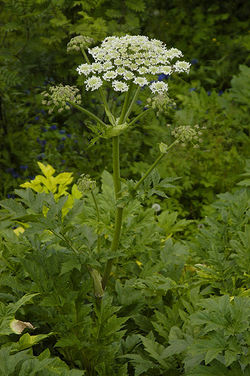Persian Hogweed
From Wikiwel
Other Names : Heracleum persicum, Golpar
Heracleum persicum is a flowering plant in the family Apiaceae native to Iran. It grows wild in humid mountainous regions in Iran, as well in some adjacent areas. Having been introduced in the 1830s, it is now very common in northern Norway, where it is known as the Tromsø palm. The plant has also been spotted in Sweden.
See also : Cow Parsnip
Special Precautions of Persian Hogweed
- Contact with the plant’s sap, if exposed to sunlight, can cause severe skin burns. The person will experience itching, redness, eczema, and stinging.
- The sap induces sensitivity to sunlight.
- Persian hogweed has a tendency to suffocate out all other native plants and wildlife, causing significant ecological damage, particularly in Natura 2000 sites.
- It also has a major economic impact due to its erosive effects and impaired drainage along river courses.
- Infertility : The Persian hogweed plant is investigated to study its effect on folliculogenesis and ovarian tissue. Studies show that the extract of the plant may have inhibitory effect on folliculogenesis. So, use of the Heracleum persicum extract could cause infertility in females.
Health Benefits and uses of Persian Hogweed
Used as : carminative, antiseptic, digestive, analgesic, anticonvulsant, flatulence, stomachs, epilepsy, pain killer
- Golpar is one of the 51 plants used to treat Tabe Reba (malaria like fever) in Iranian traditional medicine.
- This plant has antioxidant, anticonvulsant, analgesic, anti-inflammatory, antiseptic, anti-helminths and immunomodulatory activities.
- Fruit extract of H. persicum is composed of terpenoids, monoterpenes, isoterpenoid, pimpinellin, iso- pimpinellin, bergapten, isobergapten and spending.
- Angiographic : The impact of supplementation with H. persicum fruits on serum lipid concentrations in a group of patients with minimal coronary artery disease was investigated. The findings showed that serum triglycerides levels were reduced after H. persicum extract supplementation in a borderline significant manner (p=0.063). Short-term supplementation with H. persicum fruit extract might be used as an adjunctive treatment for patients with hypertriglyceridemia. The effects of supplementation with H. persicum fruit on the angiographic findings of patients with minimal coronary artery disease (CAD) was examined. The results do not support any clinically significant benefit of supplementation with H. persicum extract on the angiographic findings of in patients with minimal CAD.
- Antioxidant : The efficacy of supplementation with Heracleum persicum fruit-a common dietary spice-in modulating systemic biomarkers of oxidative stress in subjects undergoing coronary angiography was investigated. The findings of the present randomized double-blind placebo-controlled trial clearly support the efficacy of H. persicum fruit extract as a safe antioxidant supplement in subjects with minimal CAD.
- Anti-Candida Activity : The in vitro anti-Candida activity of the hydroalcoholic extracts of Heracleum persicum fruit was investigated. The results of this survey confirmed that tested plant extract had a potential anti-Candida activity. Hence, it is suggested to isolate and identify its active compounds in future.
- Lipid profile : The effect of hydroalcoholic extract and essential oil of Heracleum persicum (Apiaceae) on lipid profile of male hyperlipidemic rabbits was investigated. These findings suggest that essential oil of the plant fruits may have some benefits in reducing cardiovascular risk factors.
- Anti-diabetic : The use of hogweed extracts helped in establishing the reduction of the markers for diabetes in patients. Two of the major risk factors are hypertriglyceridemia and hypercholesterolemia for diabetes. The most commonly occurring diseases are atherosclerosis and coronary artery disease. These conditions occur after the incidence of diabetes in the patient. Use of the extract helps to decrease these risk factors significantly.
- Anti-inflammatory and analgesic properties : The anti-inflammatory and analgesic effects of the hydroalcoholic extract and essential oil of the plant fruits and analyzing the essential oil was evaluated. The results clearly show the analgesic and anti inflammatory effects of the plant essential oil and hydroalcoholic extract. Further studies are needed to clarify the mechanism of action and the components responsible for these pharmacological effects.
- Anticonvulsant : The anticonvulsant activity of acetone extract of the seeds of Heracleum persicum (Umbelliferae) was examined against pentylenetetrazole. The extract showed a dose-dependent protective effect in both seizure models. However, the sedative dose of the extract, examined by rotarod test, was close to the anticonvulsant doses. Preliminary phytochemical analysis showed the presence of alkaloids, terpenoids, triterpenes and steroids in the extract. The observed pharmacological effects could be due to alkaloids, terpenoids and triterpenes present in the plant.
- Cancer : In vitro cytotoxic activity evaluation of several plant species including H. persicum has been carried out using the brine shrimp lethality assay (Sharififar and others 2009). The essential oil of H. persicum showed the most cytotoxicity with an LC50 value of 0.007 μL/mL.
References
- Coruh N, Celep AS, Özgökçe F. Food chem . 2007;100(3):1237-42.
- Hajhashemi V, Sajjadi SE, Heshmati M. J ethnopharmacol. 2009;124(3):475-80.
- Panahi Y, Pishgoo B, Sahebkar A.heart views. 2015;16(3):85.
- Panahi Y, Dadjou Y, Pishgoo B, Akbari A, Sahebkar A.J Diet Suppl. 2016;13(5):530-7.
- Souri E, Farsam H, Sarkheil P, Ebadi F. Pharm Biol. 2008.
- Nejad BS, Rajabi M, Mamoudabadi AZ, Zarrin M.Jundishapur J Microbiol. 2014;7(1).
- Dadjo Y, Panahi Y, Pishgoo B, Sahebkar A, Taghipour H, Akbari A, et al. Phytother Res. 2015;29(1):141-3.
- Hajhashemi V, Dashti G, Saberi S, Malekjamshidi P.Avicenna J Phytomed. 2014;4(3):144.
- Sayyah M, Moaied S, Kamalinejad M. J ethnopharmacol. 2005;98(1):209-11.
- https://onlinelibrary.wiley.com/doi/full/10.1111/1541-4337.12222#crf312222-bib-0118
